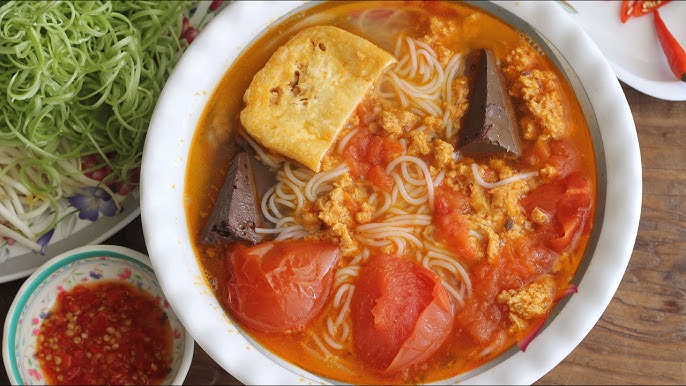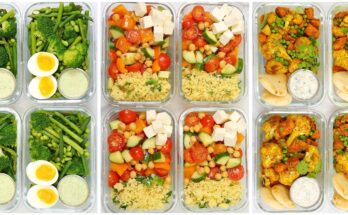Bún Riêu Recipe: Bún Riêu is a traditional Vietnamese noodle soup that combines the richness of a tomato-based broth with the delicate, savory flavors of crab paste, pork, and tofu. Unlike the more famous Phở or Bún Bò Huế, Bún Riêu stands out for its tangy, slightly sour broth and the unique use of freshwater crab or crab paste. The soup is typically served with thin rice vermicelli noodles and a generous topping of fresh herbs, making it both refreshing and comforting.
At its core, Bún Riêu is more than just a meal—it’s a cultural representation of Vietnam’s coastal and river regions, where crabs and fresh herbs are plentiful. Every spoonful of this dish reflects the ingenuity of Vietnamese home cooking, where simple, affordable ingredients come together to create something deeply flavorful and nourishing.
The Cultural Significance of Bún Riêu in Vietnam
In Vietnam, Bún Riêu isn’t just something you find in restaurants—it’s also a beloved street food dish. Small vendors often serve steaming bowls of Bún Riêu on bustling street corners, where locals gather for a hearty breakfast or lunch. The dish has also earned a spot at family gatherings and special occasions.
One of the reasons Bún Riêu is so beloved is because it feels both homely and luxurious. The crab paste, with its rich umami flavor, adds depth to the broth, while the tomatoes give it a bright, refreshing tang. Combined with herbs like perilla, mint, and Vietnamese coriander, it creates a balanced bowl that feels like a celebration of fresh flavors.
Why You Should Try Making Bún Riêu at Home
Cooking Bún Riêu at home may seem intimidating at first because of the variety of ingredients and steps involved. However, once you break it down, the process is quite manageable—and incredibly rewarding. Unlike restaurant versions, making it at home allows you to control the balance of flavors, customize the toppings, and ensure freshness.
Homemade Bún Riêu also connects you to Vietnamese culinary traditions. Even if you’ve never visited Vietnam, preparing this dish can give you a taste of its vibrant food culture right in your kitchen. And the best part? A big pot of Bún Riêu can feed the whole family, making it perfect for weekend meals or gatherings.
Ingredients You’ll Need for Bún Riêu
Core Ingredients for the Broth
The heart of Bún Riêu is its broth, which is both savory and tangy. To make it, you’ll need:
- Pork bones or chicken bones (for the base stock)
- Fresh tomatoes (to give the soup its signature tang and red hue)
- Dried shrimp (optional, but adds depth)
- Tamarind paste or rice vinegar (for sourness)
- Fish sauce (the soul of Vietnamese cooking)
These ingredients simmer together to create a flavorful and fragrant base that sets Bún Riêu apart from other noodle soups.
Essential Proteins and Toppings
What makes Bún Riêu unique is the crab paste mixture, often made by combining minced freshwater crab with pork, shrimp, and eggs. When added to the broth, it forms delicate, fluffy crab cakes that float beautifully on the surface. Other proteins include:
- Fried tofu (absorbs the broth and adds texture)
- Ground pork (for added richness)
- Blood pudding (optional, but traditional)
Herbs, Vegetables, and Garnishes
No Vietnamese noodle soup is complete without a medley of fresh herbs. For Bún Riêu, the must-haves are:
- Perilla leaves (Tía tô)
- Vietnamese coriander (Rau răm)
- Banana blossoms (thinly sliced, adds crunch)
- Bean sprouts
- Shredded lettuce
These not only enhance the flavor but also add freshness and crunch to every bite.
Noodles and Condiments
Bún Riêu uses rice vermicelli noodles (Bún), which are thin and silky, perfectly complementing the hearty broth. On the side, you’ll often find:
- Chili paste or fresh chili slices
- Lime wedges
- Shrimp paste (mắm tôm), for those who want a stronger umami punch
Together, these condiments allow each person to adjust the flavor to their liking.
Preparing the Ingredients
Prepping the Crabs or Crab Paste
Traditionally, Bún Riêu uses freshwater crabs that are pounded into a paste, then strained to extract the essence for the broth. This method is authentic but time-consuming. Most home cooks outside Vietnam use canned crab paste in soy oil, which is widely available in Asian grocery stores.
If using fresh crabs, you’ll need to:
- Clean and grind the crabs into a fine paste.
- Strain the mixture with water, separating the crab liquid from the shells.
- Use the strained liquid in the broth while the crab meat forms the crab cakes.
This process creates the signature umami flavor that defines Bún Riêu.
Preparing the Pork and Shrimp Mixture
The crab mixture often includes ground pork and shrimp for extra flavor and texture. To prepare:
- Mince shrimp finely until it forms a paste.
- Mix with ground pork, crab paste, and eggs.
- Season with fish sauce, salt, and pepper.
This mixture is dropped into the simmering broth, forming soft, savory clusters that float on the surface.
Washing and Cutting the Vegetables
Freshness is key in Bún Riêu, so vegetables and herbs should be prepped carefully. Banana blossoms need to be soaked in water with lime juice to prevent browning. Herbs should be washed thoroughly and dried before serving. Lettuce and bean sprouts should be crisp and fresh, as they add contrast to the warm broth.
Organizing the Condiments
Before you start cooking, arrange your condiments on a small tray: shrimp paste, chili paste, lime wedges, and extra fish sauce. This ensures that once the soup is served, everyone can season their bowl to taste without rushing back to the kitchen.
Step-by-Step Guide to Cooking Bún Riêu
Making the Broth Base
Start by boiling pork bones (or chicken bones if preferred) for at least one hour to create a rich, flavorful stock. Skim off impurities for a clear broth. Add dried shrimp for extra umami, then season with fish sauce and a touch of tamarind or vinegar to achieve the signature tang. Tomatoes should be sautéed in oil before being added to the broth, ensuring they release their full sweetness and acidity.
The combination of savory pork stock, dried seafood, and tangy tomatoes is what makes the broth both comforting and refreshing.
Cooking the Crab Mixture
Once the broth is ready, drop spoonfuls of the crab-pork-shrimp mixture into the pot. They will firm up as they cook, creating fluffy crab cakes that float to the top. These little clusters not only taste amazing but also give the dish its signature texture.
Adding Proteins and Tofu
Fried tofu is a must in Bún Riêu. Add it toward the end so it absorbs the broth without falling apart. If using pork blood pudding, add it carefully in large cubes. The contrast between the soft tofu and the chewy pork blood makes the dish more exciting.
Cooking the Noodles to Perfection
Rice vermicelli noodles should be boiled separately, then rinsed under cold water to prevent sticking. This ensures the soup remains clear and the noodles don’t turn mushy when combined with the broth.
Balancing the Flavors
Taste the broth and adjust the seasoning before serving. If it’s too sour, add a bit more fish sauce. If it’s too salty, balance it with a pinch of sugar. Remember, the goal is harmony—savory, tangy, slightly sweet, and umami all at once.
Assembling and Serving Bún Riêu
Arranging the Noodles in the Bowl
Start with a generous portion of cooked vermicelli noodles in a deep bowl.
Adding Toppings and Herbs
Place the crab cakes, tofu, and any additional proteins on top. Add a handful of bean sprouts, herbs, and shredded lettuce for freshness.
Pouring the Broth
Carefully ladle the steaming hot broth over the noodles and toppings, making sure to include plenty of tomatoes and floating crab mixture.
Final Garnishes and Presentation Tips
Garnish with extra herbs, a squeeze of lime, and a dollop of chili paste. For authenticity, offer shrimp paste on the side for those who enjoy a stronger kick of umami.
Bún Riêu should look colorful and inviting—red broth, green herbs, golden tofu, and white noodles coming together like a work of art.
Bún Riêu Cua (Crab Paste Version)
The most popular variation of this dish is Bún Riêu Cua, which uses crab paste or fresh field crabs as the star ingredient. This version is especially common in northern Vietnam, where freshwater crabs are plentiful. The flavor of the crab gives the broth a deep umami taste that’s hard to replicate with other ingredients. If you can get your hands on fresh crabs, the broth becomes incredibly rich, almost like a seafood stock with a tangy tomato base. Even if you use canned crab paste, you’ll still get that signature savory taste.
This version often includes ground pork and tofu to balance out the richness of the crab. The tofu soaks up the broth, creating soft little flavor bombs in every bite. Bún Riêu Cua is the standard version most people recognize, and it’s what you’ll usually find when you order the dish at restaurants or street stalls in Vietnam.
Bún Riêu Chay (Vegetarian Version)
For those who prefer plant-based meals, Bún Riêu Chay is a fantastic alternative. Instead of crab and pork, this version uses mushrooms, tofu, and sometimes vegetarian mock meats. The broth is still tangy and savory but made with a vegetable stock base, often enhanced with dried mushrooms for umami depth. Tomatoes still play a major role, giving the soup its signature flavor and color.
The toppings include fried tofu, vegan crab cakes (made with tofu skin and mushrooms), and lots of fresh herbs. This version has gained popularity not only among vegetarians but also among those who want a lighter, healthier meal without sacrificing flavor.
Bún Riêu Tôm (Shrimp Version)
Another tasty variation is Bún Riêu Tôm, which uses shrimp instead of crab. The process is similar—you create a shrimp paste mixture with minced shrimp and seasonings, then drop spoonfuls into the broth to cook. This gives the dish a slightly sweeter seafood flavor compared to the crab version.
In some cases, both shrimp and crab are combined for a richer taste. If you can’t find crab paste but have access to fresh shrimp, this version is an excellent alternative that still delivers that authentic Vietnamese flavor.
Regional Differences Across Vietnam
Like many Vietnamese dishes, Bún Riêu changes slightly depending on the region. In the north, the flavors are often lighter and more focused on the natural taste of the crab and tomatoes. In central Vietnam, you may find spicier versions with stronger seasonings. In the south, the dish tends to be more colorful and vibrant, with extra herbs, banana blossoms, and even more condiments to adjust the flavor.
These regional differences highlight the adaptability of Bún Riêu. No matter where you are in Vietnam, you’ll find a version that reflects local tastes and traditions.
Tips for Perfecting Your Bún Riêu
Common Mistakes to Avoid
Even though Bún Riêu is straightforward once you break it down, there are a few mistakes that can throw off the balance of the dish:
- Overcooking the noodles – Rice vermicelli cooks quickly, and leaving them in hot water too long makes them mushy. Always boil separately and rinse in cold water.
- Not balancing the sourness – The broth should be tangy but not overwhelmingly sour. Too much tamarind or vinegar can ruin the harmony.
- Skipping the herbs – The fresh herbs are not just decoration; they’re essential for the full flavor experience. Don’t serve Bún Riêu without them.
- Using low-quality fish sauce – Fish sauce is the backbone of the broth, so choose a high-quality brand for the best flavor.
Flavor-Enhancing Tricks
Want to take your Bún Riêu to the next level? Try these tips:
- Sauté the tomatoes first before adding them to the broth. This deepens their sweetness and adds richness.
- Toast the dried shrimp before simmering. This enhances their nutty aroma and makes the broth more flavorful.
- Add shrimp paste (mắm tôm) carefully. A little goes a long way, but it adds incredible depth when used correctly.
- Use fried shallots as a garnish. They add a crunch and a slight caramelized flavor that balances the tangy broth.
How to Store and Reheat Leftovers
Bún Riêu tastes amazing fresh, but you can also save it for later. Store the broth and noodles separately in the refrigerator. When reheating, bring the broth to a gentle boil before serving, and only add the noodles right before eating. This prevents them from getting soggy.
Leftover broth can last up to 3 days in the fridge or 1 month in the freezer. If freezing, store it in smaller portions for convenience. Just thaw and reheat when you’re ready for another comforting bowl.
Nutritional Value of Bún Riêu
Protein and Mineral Content
Bún Riêu is a nutrient-dense dish, thanks to its mix of proteins, seafood, and fresh vegetables. The crab paste and pork provide plenty of protein, while the tofu adds plant-based protein and calcium. Fresh crabs, when used, are also rich in minerals like zinc, copper, and selenium—all essential for immune health.
Calories per Serving
A typical bowl of Bún Riêu contains between 450–600 calories, depending on the toppings you add. The noodles provide carbs, the proteins add sustenance, and the vegetables balance it with fiber. Compared to many noodle soups, it’s relatively light yet filling, making it suitable for both lunch and dinner.
Making It a Balanced Meal
To keep Bún Riêu healthy and well-rounded, don’t skimp on the herbs and vegetables. The raw greens not only enhance flavor but also provide vitamins and antioxidants. If you want a lighter version, reduce the amount of pork and tofu while increasing the vegetables. For a richer meal, add more proteins like shrimp or quail eggs.
In short, Bún Riêu can be as light or as indulgent as you want—it’s all about how you balance the ingredients.
FAQs about Bún Riêu Recipe
Can I make Bún Riêu without crab?
Yes, absolutely. While crab paste gives the dish its signature flavor, you can substitute with shrimp or even create a vegetarian version using mushrooms and tofu. The broth will still be flavorful and tangy, especially with the addition of tomatoes and fish sauce.
What type of noodles should I use?
Bún Riêu traditionally uses rice vermicelli noodles (bún). These are thin, round noodles that soak up the broth perfectly. Avoid flat rice noodles (like those used in Phở), as they change the texture of the dish.
Can I freeze Bún Riêu broth?
Yes, the broth freezes very well. Just make sure to store it separately from the noodles and fresh herbs. Freeze in small containers for up to one month, then thaw and reheat when ready to enjoy.
What herbs are best for garnish?
The must-have herbs include perilla leaves (tía tô), Vietnamese coriander (rau răm), and mint. If you can’t find those, substitute with fresh basil, cilantro, and regular mint. Always serve with bean sprouts and lime for extra freshness.
How spicy should Bún Riêu be?
That depends on your taste. The broth itself isn’t very spicy, but many people add chili paste or fresh chili slices to adjust the heat. If you like bold flavors, a spoonful of chili paste and a dab of shrimp paste will transform the soup instantly.
Conclusion
Cooking Bún Riêu at home may take a little time, but the results are absolutely worth it. Once you’ve mastered the broth and the crab mixture, you’ll realize it’s not as complicated as it first appears. Plus, making it yourself allows you to tailor the dish exactly to your preferences—whether you want it more sour, spicier, or loaded with herbs.
Whether you stick to the classic crab version, try a vegetarian take, or experiment with shrimp, Bún Riêu offers endless possibilities. It’s a dish that warms the heart, delights the senses, and connects you to Vietnam’s rich culinary heritage. Next time you’re craving comfort food with a refreshing twist, skip the takeout and try a steaming, homemade bowl of Bún Riêu—you won’t regret it.



